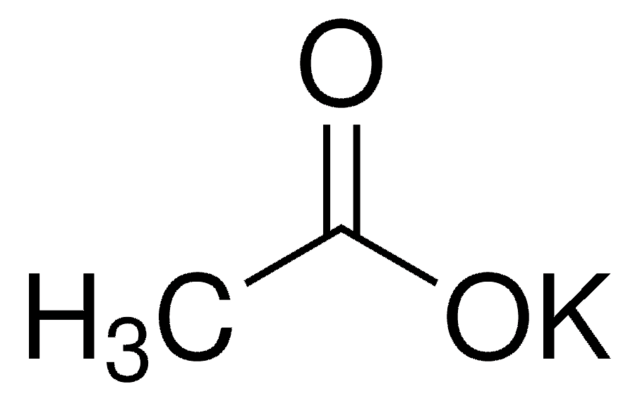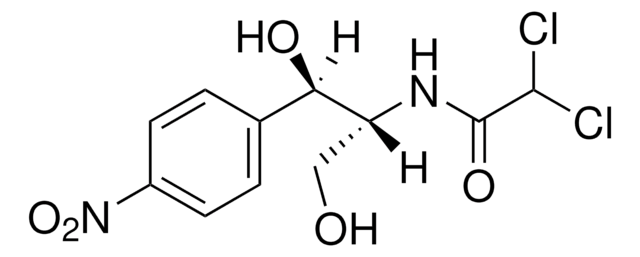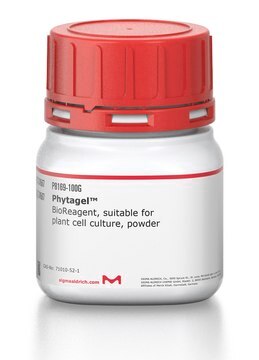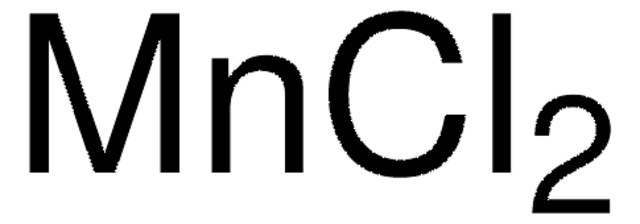83979
Rubidiumchlorid
BioUltra, for molecular biology, ≥99.0% (AT)
Synonym(e):
RbCl
About This Item
Empfohlene Produkte
Qualität
for molecular biology
Qualitätsniveau
Produktlinie
BioUltra
Assay
≥99.0% (AT)
Form
solid
Verunreinigungen
DNases, none detected
RNases, none detected
insoluble matter, passes filter test
phosphatases, none detected
proteases, none detected
Verlust
≤0.2% loss on drying, 110 °C
pH-Wert
5.0-8.0 (25 °C, 1 M in H2O)
mp (Schmelzpunkt)
715 °C (lit.)
Löslichkeit
H2O: 1 M at 20 °C, clear, colorless
Dichte
2.8 g/mL at 25 °C (lit.)
Anionenspuren
bromide (Br-): ≤100 mg/kg
iodide (I-): ≤20 mg/kg
sulfate (SO42-): ≤50 mg/kg
Kationenspuren
Al: ≤5 mg/kg
As: ≤0.5 mg/kg
Ba: ≤20 mg/kg
Bi: ≤5 mg/kg
Ca: ≤10 mg/kg
Cd: ≤5 mg/kg
Co: ≤5 mg/kg
Cr: ≤5 mg/kg
Cu: ≤5 mg/kg
Fe: ≤2 mg/kg
K: ≤5000 mg/kg
Li: ≤5 mg/kg
Mg: ≤5 mg/kg
Mn: ≤5 mg/kg
Mo: ≤5 mg/kg
Na: ≤50 mg/kg
Ni: ≤5 mg/kg
Pb: ≤10 mg/kg
Sr: ≤10 mg/kg
Zn: ≤5 mg/kg
λ
1 M in H2O
UV-Absorption
λ: 260 nm Amax: 0.03
λ: 280 nm Amax: 0.03
SMILES String
[Cl-].[Rb+]
InChI
1S/ClH.Rb/h1H;/q;+1/p-1
InChIKey
FGDZQCVHDSGLHJ-UHFFFAOYSA-M
Suchen Sie nach ähnlichen Produkten? Aufrufen Leitfaden zum Produktvergleich
Verwandte Kategorien
WGK
WGK 2
Flammpunkt (°F)
Not applicable
Flammpunkt (°C)
Not applicable
Persönliche Schutzausrüstung
Eyeshields, Gloves, type N95 (US)
Analysenzertifikate (COA)
Suchen Sie nach Analysenzertifikate (COA), indem Sie die Lot-/Chargennummer des Produkts eingeben. Lot- und Chargennummern sind auf dem Produktetikett hinter den Wörtern ‘Lot’ oder ‘Batch’ (Lot oder Charge) zu finden.
Besitzen Sie dieses Produkt bereits?
In der Dokumentenbibliothek finden Sie die Dokumentation zu den Produkten, die Sie kürzlich erworben haben.
Kunden haben sich ebenfalls angesehen
Unser Team von Wissenschaftlern verfügt über Erfahrung in allen Forschungsbereichen einschließlich Life Science, Materialwissenschaften, chemischer Synthese, Chromatographie, Analytik und vielen mehr..
Setzen Sie sich mit dem technischen Dienst in Verbindung.








